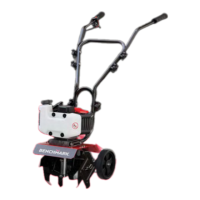33
9.7 CARBURETOR MODIFICATION FOR HIGH ALTITUDE
OPERATION
NOTE
This engine is equipped to run at altitudes below 2,000-ft.
A high-altitude main jet is recommended when operated at 2,000 to
7,000-ft above sea level.
At elevations above 7,000-ft the engine may experience decreased
performance even with a high-altitude main jet.
At high altitudes the carburetor’s air/fuel mixture becomes too rich, resulting in
higher fuel consumption, lower performance, and carbon build-up on the spark plug.
On the other hand, if the carburetor has been modied for high altitude operation
and is operated below 2000-ft, the air/fuel mixture will then be too lean for low
altitude use. Always use the correct main jet for your altitude.
The engine’s carburetor, governor (if so equipped), and any other parts that control
the air/fuel ratio will need to be adjusted by a qualied mechanic to allow efcient
high-altitude use, and to prevent damage to the engine and any other devices used
with this product. The fuel system on this engine may be inuenced by operation at
higher altitudes.
Carburetor bowl may have gas in it which will leak upon removing the
bolt.
The mixing tube is held in place by the main jet and might fall out when
it is removed. If it falls out, replace it in the same orientation before
replacing the main jet.
The fuel cup seal and bolt seal may be damaged during removal and
should be replaced with the new ones.
(Above 2,000 feet)
Carburetor
Assembly
Main Jet
Fuel Cup Seal
Mixing Tube
(might remain
inside carburetor)
Fuel Cup
Bolt Seal
Bolt
Drain Bolt
Washer
1. Turn off the engine.
2. Close the fuel valve.
3. Place a bowl under the fuel cup to catch any spilled fuel.
4. Unthread the bolt holding the fuel cup.
5. Remove the bolt, bolt seal, fuel cup, fuel cup seal and main jet from the
body of the carburetor assembly. A carburetor screwdriver (not included) is
needed to remove and install the main jet.
6. Replace the main jet with the replacement main jet needed for your altitude
range.
7. Replace the fuel cup seal, fuel cup, bolt seal, and bolt. Tighten in place. Do
not cross thread bolt when tightening. Finger tighten rst and then use a
wrench to make sure the bolt is properly threaded.
8. Wipe up any spilled fuel and allow excess to evaporate before starting
engine. To prevent FIRE, do not start the engine while the smell of fuel
hangs in the air.
HH0407

